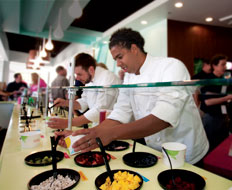At an Independence Day parade this year, a Mustang convertible rolled down the route decked out in red, white, and blue—and lots of signage for frozen yogurt chain TCBY. As the car came into view, someone with trays of yogurt samples approached folks watching the parade and offered a taste.
“This was really pure genius,” says Greg Allison, director of marketing for Salt Lake City–based TCBY. “We have a program called Street Treat Sampling where we encourage franchisees to go out and sample people within a three-mile radius of their stores. This operator saw an opportunity that encompassed everything local-store marketing is supposed to be: hands on, community-oriented, and fun.”
While corporate marketing departments are staffed with professionals who can toss out statistical analyses of potential customers with ease, their work and brainpower aren’t enough to get a quick-serve brand moving in an individual marketplace.
“There’s a huge need for local-store marketing, now more than ever,” says Shane Vaughan, vice president of marketing for Balihoo, a Boise, Idaho–based marketing and advertising agency. “National marketing just can’t do it all. It’s the local owner/operator who knows if a two-for-one deal goes better in his market than a half-off-for-one offer, and he’s better equipped to address those needs.”
Marketing executives have long been aware of the power of local-store marketing, but there is one big roadblock: figuring out how to convince franchisees to be invested in both local marketing and the national brand’s message.
“It’s really about creating a balance,” Allison says. “The great marketing minds use their franchisees as an extension of their marketing team. You’ve got to listen to their needs as well as share what you’re trying to do nationally. If you work cooperatively, everyone usually wins.”
Much of the emphasis in local-store marketing has become focused on building a local presence through social media such as Facebook and Twitter. “Because messages in these mediums are short, they’re usually based on offers,” Vaughan says. “‘Come by our store between 3 p.m. and 6 p.m. and get a free drink with your order’—that kind of thing. They’re quick hits designed to drive traffic.”
Tweets and Facebook messages can also be linked to a landing page that may or may not be tied to the national marketing department. Earlier this year, TCBY launched a series of webinars and tutorials with franchisees to teach them everything from the definition of social media and how it works to how to develop a local social media campaign.
“We rolled out microsites for our local owners, which are user-friendly websites that allow a franchisee to customize their own Web presence,” Allison says. “They’re very easy to navigate, with pull-down menus and templates, and they allow you to create a site for your store in just 20–30 minutes.
“Operators can be linking Twitter and Facebook messages back to the site and start a full-fledged local campaign in less than an hour.”
The speed and flexibility of social media is a big attraction for many quick-serve franchisees. “When you look at the time spent printing door hangers and the cost of distributing them, compared to doing your marketing on the Web, it’s a no-brainer,” Vaughan says. “It’s created an environment where, soon, this isn’t just optional—you will have to be up using social media marketing to maintain your business.”
In addition to using Web-based social media, text-message programs are gaining popularity. “Using text-message marketing is more personal and just as easy as Facebook and Twitter,” says Bryce Marshall, director of strategic services at Knotice, an Akron, Ohio–based direct digital marketing company. “You’re addressing people who’ve already shown an interest in what you do, so there’s a greater ROI. It’s pinpoint marketing on a hyper-local level.”
However, acquiring mobile phone numbers for target customers is a challenge. Most outlets that do this have heavy advertising that emphasizes all the offers customers can get if they submit their number. “There are a percentage of your customers who are going to be loyal to your brand or loyal to your location,” Marshall says. “These are the people who are most open to giving you their contact numbers, and they’ll be the ones showing up when you’ve sent them a good offer.”
While there are obvious advantages to using social media for local-store marketing, some franchisees still say old-fashion programs are the best.
“We work closely with schools, charities, and nonprofits to promote what we call Donation Days,” says Tom Jones, co-owner of four Cousins Subs franchises in the Milwaukee area. “Ten percent of the profits from that day go to the charity. The people around here love it and you can really see the support some of these organizations have. On some days you might get 100 or more people who support a charity come in to eat, many of whom haven’t been here before.”
“One of the things we call attention to with our franchisees is that while lots of local businesses do fundraisers, they should try to go the extra mile,” says Lisa Prouhet, director of marketing for Stevi B’s Pizza in Atlanta. “They should get to know the local principals, church, and community leaders. Once you build a relationship with someone, especially if it’s face to face, it’s easier for them to remember you compared to another, similar business.”
Jones, who spent several years in the corporate marketing department at Cousins before taking on a role as a franchisee, says seeing both sides of the business gave him rare insight. “When I talk to headquarters about the corporation’s marketing goals, I’m able to communicate to them how we as franchisees can add to it with our own efforts,” he says. “I’m convinced that we as owners can’t do it alone; we need that national marketing to create a strong brand presence. But we also have to roll up our sleeves and drive traffic to our own stores. Local-store marketing is something that will never go away.”









